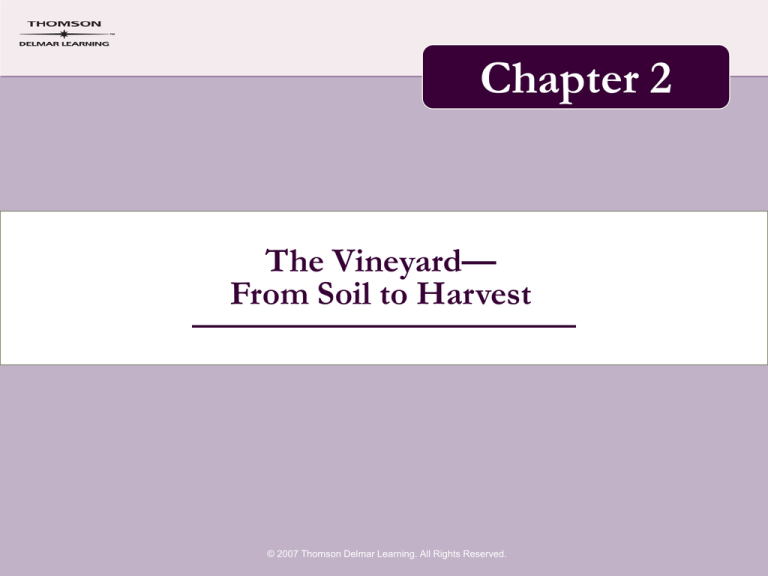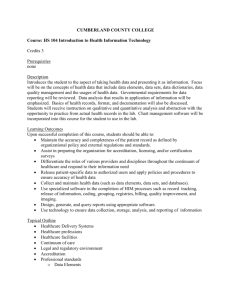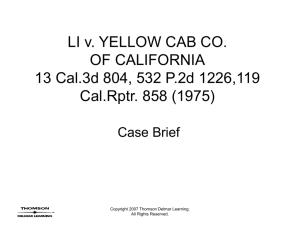
Chapter 2
The Vineyard—
From Soil to Harvest
© 2007 Thomson Delmar Learning. All Rights Reserved.
Objectives
• After reading this chapter, you should be able to
– display an understanding of how grapes are grown
for wine production.
– describe the annual growing cycle of a grapevine.
– explain how the grapevine’s environment affects the
crop it produces.
© 2007 Thomson Delmar Learning. All Rights Reserved.
Introduction
• Great wines are made from great grapes, and the
ultimate quality of a wine is determined in the
vineyard as much as it is at the winery.
– Many fruit crops are grown with an emphasis on
appearance.
– Many agricultural crops are grown as a commodity.
– Premium wine grapes are one of the few crops that are
still grown primarily for their flavor.
© 2007 Thomson Delmar Learning. All Rights Reserved.
Introduction (continued)
• There are two factors that influence the
character of grapes from a given vineyard:
environmental and cultural.
– Environmental factors are all the natural
attributes of the vineyard site.
– Cultural practices are all the actions performed by
the grower.
© 2007 Thomson Delmar Learning. All Rights Reserved.
Grapes Used for Winemaking
• Grapes are the preferred fruit for wine
production.
– Grape juice has all the attributes necessary for
fermenting the juice.
– The outside of the grape berry is covered with a
waxy layer that contains naturally occurring yeast.
– The great majority of wine produced in the
world is from grapes.
© 2007 Thomson Delmar Learning. All Rights Reserved.
Vitis vinifera
• There are many indigenous species of grapes
worldwide, but the overwhelming majority of wine
produced is from the species Vitis vinifera.
– This species is native to Asia Minor.
– Within the species Vitis vinifera there are over 5,000
named cultivars; only a fraction are grown commercially.
– Grapevines can be propagated by using cuttings to form
a separate vine that is a clone of the original vine.
© 2007 Thomson Delmar Learning. All Rights Reserved.
Other Species of Grapes
• Although the vinifera grape is very versatile, it is not
well suited to cold or humid climates.
• In the Eastern United States, native grape varieties
such as Concord and Scuppernong are grown for
winemaking.
– Indigenous to the East Coast of North America, they are
naturally resistant to pests of the region.
• To combine the hardiness of American varieties
with the flavors of European (vinifera) varieties, the
two were crossbred to produce hybrids.
© 2007 Thomson Delmar Learning. All Rights Reserved.
Other Species of Grapes (continued)
• Native and hybrid varieties are planted throughout
the Eastern United States but have not found wide
acceptance with consumers.
• In the 1880s European interest in developing new
grape varieties for winemaking led to the
importation of native American grapes.
– They brought with them several grape pests and diseases.
– Downey mildew, powdery mildew, black rot, and
phylloxera quickly spread throughout Europe.
© 2007 Thomson Delmar Learning. All Rights Reserved.
Phylloxera and Grafting
• Vines brought from France further spread
phylloxera to California and the rest of the world.
• Grafting takes a cutting, or scion, from a vinifera
variety and affixing it to a rootstock from American
grapes that are phylloxera resistant.
• The result is a vine that has roots that are resistant
to phylloxera and produces vinifera fruit for
winemaking.
– There are many different rootstocks that are adapted to a
variety of growing conditions.
© 2007 Thomson Delmar Learning. All Rights Reserved.
Soil and Site
• Soils that are shallow or low in nutrients will put
pressure on the grapevines resulting in lower
cropload with less vegetative growth.
– If there is less vegetative growth, the grape clusters will
not be as shaded by the leaves; sun exposure on Cabernet
Sauvignon clusters will give them more fruity aromas and
less of a herbaceous aroma.
– Grapes grown in fertile soils can also produce highquality fruit, but they must be managed properly.
© 2007 Thomson Delmar Learning. All Rights Reserved.
Soil and Site (continued)
• There are a number of parameters that go into a
soil’s makeup:
– The parent material or rock of which it is comprised
– The size of the particles the soil is made of:
• clay is made of very fine particles
• silt has larger particles than clay
• sand has larger particles than silt
– The chemical composition of the soil
– The organic matter and nutrients in the soil
– The depth of the soil
© 2007 Thomson Delmar Learning. All Rights Reserved.
Soil and Site (continued)
• Soils are characterized by the ratio of sand, silt, and
clay that are present in them.
– Soils that have a high ratio of clay are said to be heavy.
– Sandy soils are called light.
– Loam is a mixture of clay, silt, sand, and organic matter
that is fertile and drains well.
– Alluvial soils lie in the floodplains that flank rivers and
streams; they are usually a mix of silt, sand, gravel, and
loam.
• Grapevines need adequate, but not excessive,
nutrients from their soil for healthy growth.
© 2007 Thomson Delmar Learning. All Rights Reserved.
Soil and Site (continued)
• A vineyard’s topography is as important as its soil.
– A vineyard on a south-facing hillside will absorb more
sunlight and be warmer than the north side of the hill.
– Hillside vineyards have better drainage but will be more
susceptible to erosion and wind damage.
– Cold air will settle into valleys and low-lying areas on still
mornings without wind making these locations more
susceptible to spring frost and winterkill.
© 2007 Thomson Delmar Learning. All Rights Reserved.
Climate
• Climate has a great influence on wine grape quality.
• Grapevines do best in temperate zones between 30
and 50 in latitude north or south.
• In this zone winters are sufficiently cold enough to
allow the vines to drop their leaves and go dormant,
but do not often cause winterkill.
– Grapes also require adequate rainfall or irrigation to
support growth and crop development.
© 2007 Thomson Delmar Learning. All Rights Reserved.
Climate (continued)
• These broad weather conditions of a
particular wine-growing region are defined as
the macroclimate.
• The weather in a particular vineyard or
portion of a vineyard is referred to as the
mesoclimate or microclimate.
– Grape varieties not only have a wide range of
color and flavors, they are also suited to a
diversity of climates.
© 2007 Thomson Delmar Learning. All Rights Reserved.
Terroir
• Terroir is the French term to describe all the
environmental factors that nature imparts to
a given vineyard.
– Terroir is a holistic philosophy and relates to all
the properties of the soil, topography, and all the
climatic conditions.
– The concept of terroir is not only having the
proper environment to grow grapes but also
matching the variety and vineyard management
to suit the terroir.
© 2007 Thomson Delmar Learning. All Rights Reserved.
Techniques of Grape Growing
• Before the vineyard is planted, the site must
be chosen and prepared for planting the
grapes.
– The soil can be tested and amendments to the
soil can be tilled into it if necessary.
– Pests and diseases can be controlled by using a
rootstock that is resistant to them or by
fumigating the soil before planting.
© 2007 Thomson Delmar Learning. All Rights Reserved.
Trellising
• Grapevines are grown on an artificial support called
a trellis.
• There are many different types of trellis systems
from the simple to the complex, and they are used
according to varying viticultural situations.
– High vigor vines with lots of vegetative growth will
benefit from a complex trellis.
– Low vigor vines will not have an enough growth to fill a
large trellis, so a simpler system is used.
• A vineyard’s vigor is directly related to its yield.
© 2007 Thomson Delmar Learning. All Rights Reserved.
The Growing Season
• Grapevines are deciduous, losing their leaves
and going dormant over the wintertime.
– A dormant vine is more tolerant of cold
temperatures
– This dormancy creates an annual cycle of the
growing season that begins in the spring and ends
in the fall after harvest.
© 2007 Thomson Delmar Learning. All Rights Reserved.
Budbreak
• The growing season begins in the early spring usually
between February and April in the Northern Hemisphere.
• When the average temperature reaches 50°F (10°C), the
vines end their winter dormancy.
• Shoots, or canes, sprout from the buds and begin to grow
quickly. At this point, the shoots are sensitive to subfreezing
temperatures.
– Spring frosts are common in low-lying vineyards where the cold air
can settle in the early morning hours.
– Vines are protected from frost by wind machines or sprinklers.
© 2007 Thomson Delmar Learning. All Rights Reserved.
Bloom
• Flower clusters at the base of the young shoots look
like miniature clusters of grapes.
– About eight weeks after budbreak, they begin to bloom.
– Once fertilized, a grape flower will begin to develop into
a berry.
– If a flower is not fertilized, it will drop off the cluster in a
process called shatter.
– For optimum pollination, warm, even temperatures are
desired, without too much wind or wet weather.
© 2007 Thomson Delmar Learning. All Rights Reserved.
Véraison
• Véraison is the beginning of ripeness and starts in
mid to late summer about eight to ten weeks after
bloom.
• At véraison:
– The hard and green berries begin to swell and change
color.
– The sugar from photosynthesis is now going into fruit
development instead of vegetative growth.
– Irrigation is diminished to help the fruit ripen by slowing
vine growth.
© 2007 Thomson Delmar Learning. All Rights Reserved.
Harvest (continued)
• Six to ten weeks after véraison the grapes will be
ready for harvest.
– The time of harvest depends on the variety, the weather
conditions, and the degree of ripeness desired.
– To determine when the grapes are ready to be picked,
samples are taken and analyzed for flavor, chemistry, and
appearance.
– The decision to harvest is based on the maturity of the
fruit as well as operational concerns.
© 2007 Thomson Delmar Learning. All Rights Reserved.
Harvest (continued)
• Grapes can be picked either by hand or by
machine.
• Hand picking
– is gentle to both the fruit and the vines
– is selective: only the healthy ripe fruit is picked
– requires more labor
© 2007 Thomson Delmar Learning. All Rights Reserved.
Harvest (continued)
• Mechanical harvesters
– are not as gentle or selective.
– have the advantage of also being operated at
night so that they will bring in cooler fruit.
– require less labor (more cost-effective).
• Both methods, if done properly, can provide
the winery with high-quality fruit.
© 2007 Thomson Delmar Learning. All Rights Reserved.
Dormancy
• At the first frost after the harvest, the leaves will fall
off marking the beginning of the winter dormancy
period.
• While the vine is dormant, no new growth occurs
and it is much less sensitive to cold weather.
• Vineyard operations during dormancy include
– adding fertilizers and soil adjustments.
– a cover crop that may be planted to control erosion.
– pruning the vines.
© 2007 Thomson Delmar Learning. All Rights Reserved.
Pruning
• After a vine is established, the process of
pruning removes almost all the new growth
from the previous year.
• Each bud left on the vine will produce a new
shoot in the spring, and the amount of the
next season’s crop is determined by the
number of buds.
© 2007 Thomson Delmar Learning. All Rights Reserved.
Pruning (continued)
• There are two types of pruning:
– Cane pruning—healthy canes are selected from
the past season’s growth and trained along wires;
each bud on the cane will grow a new cane of its
own in the spring.
– Spur pruning—the grapevine is grown with
permanent arms or cordons that have spurs
located about every six to eight inches along their
length. Each spur will have several buds on them
for the next year’s growth.
© 2007 Thomson Delmar Learning. All Rights Reserved.
Pruning (continued)
• The most important concept in pruning is balance.
This is where the vine is left with the appropriate
amount of buds to produce the correct cropload.
– Overcropped vines will have a difficult time producing
enough sugar to get the grapes ripe.
– Undercropping also has undesirable consequences
because if there is not enough crop the vine will put too
much energy into vegetative growth.
© 2007 Thomson Delmar Learning. All Rights Reserved.
Organic Viticulture
• Organic viticulture is the practice of growing
grapes without the use of any manmade
substances.
– In an organic vineyard, weed control is done by
tilling or planting of cover crops. Elemental
sulfur can still be used to combat rot, but
synthetic chemicals cannot be used.
– Excellent grapes can be grown organically, but
the extra handwork required makes them more
expensive to grow.
© 2007 Thomson Delmar Learning. All Rights Reserved.
Sustainable Viticulture
• Sustainable viticulture promotes agricultural
practices that allow the minimal use of
pesticides in the vineyard.
– This encourages the development of a natural
vineyard ecosystem with predatory insects to help
combat grape pests.
– Sustainable grape growing is a popular option
because it provides much of the benefits of
organic farming, with less risk and a lower cost
of labor.
© 2007 Thomson Delmar Learning. All Rights Reserved.
Major Grape Varieties
• Although there are thousands of varieties of
Vitis vinifera that are grown for winemaking,
only a few make up the vast majority of
production.
© 2007 Thomson Delmar Learning. All Rights Reserved.
Barbera
• Barbera produces intensely colored, tart
wines with moderate tannins.
• It is native to the Piedmont region of Italy.
• The grape’s tendency to hold on to its acid in
warm climates made it popular as a “blender”
in wines from warm areas.
• Interest in growing premium Italian varietals
have led to increased plantings in the coastal
growing regions in California.
© 2007 Thomson Delmar Learning. All Rights Reserved.
Cabernet Franc
• From the Bordeaux and Loire regions of France.
• Has small berries and loose to compact clusters.
Related to Cabernet Sauvignon, it typically produces
wines with less complexity and lighter tannins and
color than its relative does.
• It is most often used for blending with Cabernet
Sauvignon and Merlot in a Bordeaux-style blend.
© 2007 Thomson Delmar Learning. All Rights Reserved.
Cabernet Sauvignon
• The classic variety of Bordeaux, it is one of the most
popular varieties grown worldwide.
• It is a late season ripener with loose clusters and thickskinned berries that make it resistant to rot.
• It is known for its excellent color and tannins combined with
complex flavor.
• In 1997 DNA research determined that Cabernet Sauvignon
is a cross between Cabernet Franc and Sauvignon Blanc.
• While 100 percent of Cabernet Sauvignons are often made
with great success, blending with other Bordeaux varieties
makes a more balanced and complex wine.
© 2007 Thomson Delmar Learning. All Rights Reserved.
Chardonnay
• One of the best known white varieties, Chardonnay
comes from the Burgundy and Chablis regions of
France.
• It is a mid-season ripener allowing it to be grown in
cool regions.
• A versatile variety can be made in a number of
styles.
• Chardonnay’s popularity resulted in extensive
planting in California throughout the 1980s and
1990s.
© 2007 Thomson Delmar Learning. All Rights Reserved.
Chenin Blanc
• Chenin Blanc is native to the Loire Valley of France.
• It is a prodigious producer and adapts well to a
number of different soils and climates.
• It is popular throughout the world, although in most
areas outside of France it is considered a simple
grape and used for making inexpensive wines.
• Usually made into a clean, crisp, wine with a
minimum of oak aging, it can be made in either
sweet or dry styles.
© 2007 Thomson Delmar Learning. All Rights Reserved.
Gewürztraminer
• Gewürztraminer is a white grape, but unlike other
white varieties, it turns a deep russet color at
ripeness instead of staying green or yellow.
• Cool growing conditions help to bring out the
distinct floral-spicy aroma for which the variety is
famous.
• Gewürztraminer makes a delicious dry wine;
however, it is best known for it sweeter styles
including late harvest dessert wines.
© 2007 Thomson Delmar Learning. All Rights Reserved.
Grenache
• Grenache is the most popular grape in the Southern
Rhône Valley, where it is the mainstay of the Rhône
blend Châteauneuf du Pape.
• It has ripe, fruity, plum-like flavors with moderate
tannins—qualities that make it useful for blending
with Syrah, which can be more tannic.
• It thrives under warm growing conditions and can
support a large cropload on fertile soils.
• In cooler areas with a lighter crop, it produces much
better wine.
© 2007 Thomson Delmar Learning. All Rights Reserved.
Merlot
• Merlot is from the Bordeaux region where it is
sometimes made into a wine by itself, but more
often is blended with Cabernet Sauvignon.
• It has similar flavors to Cabernet but has a softer
mouth feel and gets ripe earlier in the season.
• Merlots have become popular because the good
flavors and the lighter body make it more
approachable with novice wine drinkers.
• Its consumer acceptance has made it one of the
most widely planted grapes in California. Its success
has led to overplanting.
© 2007 Thomson Delmar Learning. All Rights Reserved.
Muscat Blanc
• Also called Muscat Canelli, it is a member of the
Muscat family of grapes.
• There are more than 200 different varieties of
Muscat with varying skin color and flavor.
• It has a distinct “Muscat aroma” that is described as
intensely fruity and floral.
• It can be made in a variety of styles from a lightbodied and dry table wine to a fortified dessert wine.
© 2007 Thomson Delmar Learning. All Rights Reserved.
Petite Sirah
• Called Durif in France, it is descended from a cross
between Syrah and Peloursin.
• Petite Sirah has found a great deal of popularity in
California.
• It makes a deeply colored, full-bodied wine with lots
of fruity aromas.
• While it makes an excellent varietal wine, it is often
blended with other reds, particularly Zinfandel.
© 2007 Thomson Delmar Learning. All Rights Reserved.
Pinot Blanc
• Known as Pinot Bianco in Italy and Weissburgunder
in Germany and Austria, it is a green-skinned clone
of Pinot Gris.
• Pinot Blanc does best in cool areas and has flavors
that are similar to Chardonnay, but more delicate in
nature.
• In Europe, it is generally used to make crisp, lightbodied wines with a minimum of oak aging.
• In California, a riper style is produced with more
body and often more oak.
© 2007 Thomson Delmar Learning. All Rights Reserved.
Pinot Gris/Pinot Grigio
• This is known as Pinot Gris in France and Pinot
Grigio in Italy.
• The parent of Pinot Blanc, Pinot Gris itself is
mutated from the red variety Pinot Noir.
• Although it produces a white wine, the clusters have
a light pinkish/brown color.
• It is an early season ripener and is popular in cool
regions with short growing seasons.
• It is currently one of the fastest growing varieties in
America in terms of consumption, due to imports
as well as new plantings.
© 2007 Thomson Delmar Learning. All Rights Reserved.
Pinot Noir
• The primary grape of Burgundy, it has a reputation for
producing excellent, long-aging wines.
• It also has a reputation for being both difficult to grow
and make into wine.
• Pinot Noir has many clones, from those that are suited
to sparkling wine production to “Burgundy” clones for
table wine.
• It ripens early and does best in cool conditions.
• It is a delicate wine and must be treated very gently at
the winery so that the balance and flavor is not lost.
© 2007 Thomson Delmar Learning. All Rights Reserved.
Riesling
• Called White Riesling or Johannisberg Riesling in the
United States, it is the most famous variety grown in
Germany.
• Riesling is similar in character to Gewürztraminer.
• In cool areas, the fruity qualities and tart acid that the
grape is known for are preserved.
• It can be made in a number of styles from dry, tart table
wines to sweet dessert wines.
• In the 1970s it was the most expensive grape grown in
California; however, it fell out of favor as the public
started to drink more dry wines.
© 2007 Thomson Delmar Learning. All Rights Reserved.
Sangiovese
• Sangiovese is the classic grape of the Tuscany region
and is the major variety in Chianti wines.
• The variety’s thin-skinned berries leave it vulnerable
to rain and high temperatures at ripeness, and it can
sometimes have light color.
• It produces tart wines with medium body and
cherry flavors.
• Sangioveses do well on their own or blended with
other red varieties such as Merlot or Cabernet
Sauvignon.
© 2007 Thomson Delmar Learning. All Rights Reserved.
Sauvignon Blanc
• Sauvignon Blanc, also known as Fumé Blanc, grows
vigorous vines that produce tight clusters of thinskinned berries.
• The thin skins make it very susceptible to rot.
• It has a distinct varietal aroma that runs a spectrum that
includes vegetative, grassy, gooseberry, and melon.
• When grown under cool conditions, the varietal
character can become very intense.
• The classic white variety of the Graves district in
France, it has also found acclaim in New Zealand and
California.
© 2007 Thomson Delmar Learning. All Rights Reserved.
Tempranillo
• The dominant grape used in Rioja wines of Spain
and widely planted in Argentina, Tempranillo has
vigorous vines that ripen early in the season and
produce thick-skinned berries.
• It makes an intense wine with excellent color and
tannins, and its aroma typically has notes of
strawberries and plums with earthy overtones.
• It is also grown in Portugal where it is known as
Tinta Roriz.
© 2007 Thomson Delmar Learning. All Rights Reserved.
Viognier
• From the Rhône region, this distinctive grape is
difficult to grow and has low yielding vines.
• It makes a relatively low acid wine with very intense
tropical and floral fragrances.
• Sometimes it is blended with other varieties to add
structure and tone down the strong aromas.
• It is becoming increasingly popular in California, but
is still not widely planted.
© 2007 Thomson Delmar Learning. All Rights Reserved.
Zinfandel
• Native to Europe, Zinfandel is best known in California.
• Recent DNA analysis has determined it to be the
Croatian variety Crljenak Kastelanski.
• In Croatia only twenty vines were found to be still in
production.
• It has large, thin-skinned clusters that have a tendency
to become overripe in hot weather, resulting in a high
alcohol wine that has a “raisiny” character.
• It makes a full-bodied wine with blackberry and pepper
flavors and light tannins.
© 2007 Thomson Delmar Learning. All Rights Reserved.
Summary
• Growing premium wine grapes is collaboration
between the winemaker and grower.
– The vintner lets the grower know what qualities are
wanted in the fruit, and the grower manages the vineyard
in a way that will deliver them.
• Market conditions in the wine business also affect
prices where popular varieties in high demand to the
consumer are worth more than varieties that have
fallen out of favor.
© 2007 Thomson Delmar Learning. All Rights Reserved.
Summary (continued)
• The best grapes are usually produced from
vineyards that have a long and mutually
beneficial relationship with the winery.
• In these situations, a trust between the
grower and the winemaker develops, and the
grower knows exactly what kind of fruit that
the winemaker wants.
© 2007 Thomson Delmar Learning. All Rights Reserved.







